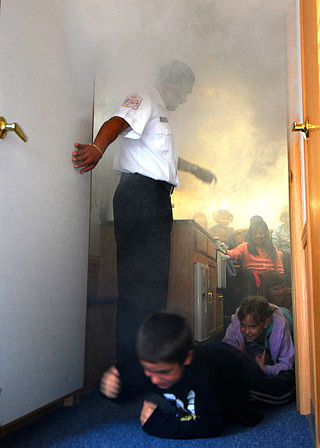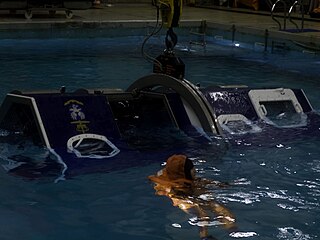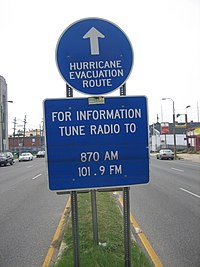
A fire drill is a method of practicing how a building should be evacuated in the event of a fire or other emergencies. In most cases, the building's existing fire alarm system is activated and the building is evacuated by means of the nearest available exits, as if an emergency had actually occurred. Fire drill procedures may vary depending on the building type, such as hospitals or high rise buildings, where occupants may be relocated within the building as opposed to evacuating the building. Generally, the evacuation interval is measured to ensure that it is fast enough, and problems with the emergency system or evacuation procedures are identified so that they may be remedied.
Earthquake preparedness is a set of measures taken at the individual, organisational and societal level to minimise the effects of an earthquake. Preparedness measures can range from securing heavy objects, structural modifications and storing supplies, to having insurance, an emergency kit, and evacuation plans.

The concept of home improvement, home renovation or remodeling is the process of renovating, making improvements or making additions to one's home. Home improvement can consist of projects that upgrade an existing home interior, exterior or other improvements to the property. Home improvement projects can be carried out for a number of different reasons; personal preference and comfort, maintenance or repair work, making a home bigger by adding rooms/spaces, as a means of saving energy, or to improve safety.

Fire safety is the set of practices intended to reduce destruction caused by fire. Fire safety measures include those that are intended to prevent the ignition of an uncontrolled fire and those that are used to limit the spread and impact of a fire.

An emergency exit in a building or other structure is a special exit used during emergencies such as fires. The combined use of regular and emergency exits allows for faster evacuation, and emergency exits provide alternative means of evacuation if regular exits are inaccessible.

Emergency management or disaster management is a science and a system charged with creating the framework within which communities reduce vulnerability to hazards and cope with disasters. Emergency management, despite its name, does not actually focus on the management of emergencies, which can be understood as minor events with limited impacts and are managed through the day-to-day functions of a community. Instead, emergency management focuses on the management of disasters, which are events that produce more impacts than a community can handle on its own. The management of disasters tends to require some combination of activity from individuals and households, organizations, local, and/or higher levels of government. Although many different terminologies exist globally, the activities of emergency management can be generally categorized into preparedness, response, mitigation, and recovery, although other terms such as disaster risk reduction and prevention are also common. The outcome of emergency management is to prevent disasters and where this is not possible, to reduce their harmful impacts.
Evacuation simulation is a method to determine evacuation times for areas, buildings, or vessels. It is based on the simulation of crowd dynamics and pedestrian motion. The number of evacuation software have been increased dramatically in the last 25 years. A similar trend has been observed in term of the number of scientific papers published on this subject. One of the latest survey indicate the existence of over 70 pedestrian evacuation models. Today there are two conferences dedicated to this subject: "Pedestrian Evacuation Dynamics" and "Human Behavior in Fire".
Firefighting jargon includes a diverse lexicon of both common and idiosyncratic terms. One problem that exists in trying to create a list such as this is that much of the terminology used by a particular department is specifically defined in their particular standing operating procedures, such that two departments may have completely different terms for the same thing. For example, depending on whom one asks, a safety team may be referred to as a standby, a RIT or RIG or RIC, or a FAST. Furthermore, a department may change a definition within its SOP, such that one year it may be RIT, and the next RIG or RIC.

A fire escape is a special kind of emergency exit, usually mounted to the outside of a building or occasionally inside but separate from the main areas of the building. It provides a method of escape in the event of a fire or other emergency that makes the stairwells inside a building inaccessible. Fire escapes are most often found on multiple-story residential buildings, such as apartment buildings.

Aircraft rescue and firefighting (ARFF) is a type of firefighting that involves the emergency response, mitigation, evacuation, and rescue of passengers and crew of aircraft involved in aviation accidents and incidents.

Overwing emergency exits are found on passenger aircraft to provide a means of evacuation onto the wing, where passengers continue off the trailing edge, either by sliding down the extended flaps or by using an evacuation slide that deploys when the exit is opened.

Helicopter Underwater Egress Training ; often abbreviated as HUET, pronounced hue-wet, hue-way or you-way) is training provided to helicopter flight crews, offshore oil and gas industry, law enforcement personnel, and military personnel who are regularly transported by helicopters over water. As the name implies, the purpose of this training is to prepare passengers and crew for an emergency evacuation or egress in the event of a crash landing on water.

Emergency aircraft evacuation refers to emergency evacuation from an aircraft which may take place on the ground, in water, or mid-flight. There are standard evacuation procedures and special evacuation equipment.

Hurricane evacuation is the immediate and rapid movement of people away from the threat or actual occurrence of a hurricane. County judges, emergency managers and other officials may recommend a voluntary evacuation or order a mandatory evacuation.
Pre-movement time is the time going from the start of and emergency requiring an evacuation and the time an household or a pedestrian start moving towards a safe place. The term is generally used in referring to both large-scale and small evacuations. Events that can require pre-movement time include building fires,hurricanes, wars, nuclear accidents, and major conflagrations.
An exit sign is a pictogram or short text in a public facility denoting the location of the closest emergency exit to be used in case of fire or other emergency that requires rapid evacuation. Most relevant codes require exit signs to be permanently lit at all times.

Vertical and horizontal evacuation are strategies for providing safety to humans in case of tsunami, hurricane or other natural disaster.
ISO 7010 is an International Organization for Standardization technical standard for graphical hazard symbols on hazard and safety signs, including those indicating emergency exits. It uses colours and principles set out in ISO 3864 for these symbols, and is intended to provide "safety information that relies as little as possible on the use of words to achieve understanding."

Erica Kuligowski is an american social research scientist investigating human behavior during emergencies and the performance of evacuation models in disasters. She currently works at RMIT university in Melbourne (Australia). Kuligowski used to work the Engineering Lab of the National Institute of Standards and Technology conducting research on several fire disasters including the NIST Hurricane Maria Project.

The COVID-19 pandemic coincided with record-breaking wildfires in the western United States and a record number of hurricane landfalls in the southeastern United States. Emergency evacuation may be required for people living in areas threatened by natural disasters. Historic procedures maximizing capacity of public transport and emergency shelters may be inconsistent with quarantine and physical distancing measures related to the COVID-19 pandemic. It is not advisable to set up congregate shelters in an environment heavily impacted by a pandemic. Non-congregate shelters typically provide more effective physical distancing. Examples include buildings with single room occupancy, hotels or dormitories with private sleeping spaces but possibly shared bathroom or cooking facilities. Thousands of evacuees from Hurricane Laura were still in emergency lodgings as Hurricane Delta approached the Louisiana coast. Six-thousand from southwest Louisiana were in twelve New Orleans area hotels. Three-thousand-five-hundred remained in shelters as Hurricane Zeta approached Louisiana. A volcanic eruption on the island of Saint Vincent in April 2021 caused evacuation of sixteen-thousand people. Four-thousand evacuees were placed in eighty-nine government shelters after being tested for COVID-19, with those testing positive taken to isolation centers. Six-thousand evacuees found shelter in private homes.




















